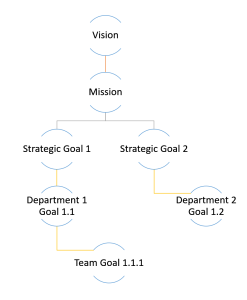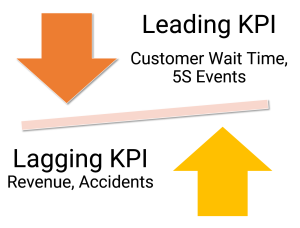What is Hoshin Kanri?
Hoshin Kanri is a Japanese term for what we typically call Policy Deployment or Strategic Planning in English. Basically, Hoshin planning is a specific way of performing a strategic plan that cascades Long Term Objectives down to Short Term Objectives. Additionally, it then continues to break the strategy into smaller components throughout the organization.
If you’re new to the concept here is a quick primer:
Hoshin Kanri is a Japanese term for what we typically call Policy Deployment or Strategic Planning in English.
The 6 Steps of Hoshin Kanri (also known as Hoshin Planning, Strategy Deployment, Strategic Planning)
Hoshin Kanri Step 1: Define Your Strategy
To start your Hoshin Planning certainly think long term. What does success look like in 10 years, 30 years? Your company’s Vision and Mission statements are a good place to start if they have been well written. Undoubtedly start with the Vision Statement. This statement answers the questions, “Why do we exist as an organization?” or “How is the world a better place because of us?” For KPI Fire our Hoshin Kanri starts with the following Vision Statement:
“KPI Fire exists to help organizations around the world better execute their own strategy which enables global prosperity.”
Evidently we start the magic of Hoshin Kanri which is taking this long term view and breaking it down into smaller bite size pieces starting with our Mission Statement.
A Mission Statement is typically a 3 to 5 year goal that answers the question: “What will we accomplish in the next 3 years that will move us closer to our established Vision?”
“KPI Fire’s mission is to become the industry standard and #1 choice for Hoshin Kanri and Strategic Planning Software in the world within the next 3 years.”
Likewise, a mission is an ambitious goal you accomplish as a team. Once accomplished, the team can move on to another mission. Mission Statements should reflect this and be changed once the first mission has previously been completed.
Hoshin Kanri Step 2: Define Your KPIs
Consequently, determining which Key Performance Indicators you will use to measure the success of your business is critical to successful Hoshin Kanri. Remember that there are different types of KPIs (or metrics), leading and lagging indicators, measures of performance and measures of activity. KPIs should be cascaded throughout each department and layer of the organization.
Hoshin Kanri Step 3: Establish and Link Your Goals or Objectives
Overall your Hoshin Plan shows where you’re headed and how you will measure success. Secondly, set a small number of long term objectives. Typically these are things you want to accomplish in the next 3 to 5 years. Shortly, break those objectives down into annual strategic objectives. Be careful. If you have too many, then the organization will be unable to invest sufficient resources or time to achieve all of your goals and your risk not achieving any of the goals. Use market research and data to make your decisions, not emotion. Look at your data, your value stream maps, and other sources to determine which objectives will have the most impact. Use the success criteria created in step 2, your KPIs, whenever you can to guide the process.
Comparatively there should be a direct link from each Goal to a corresponding metric. Is there a match?
Here’s a simple example:
KPI – Safety Incidents
Leading KPI – Cleanliness Score of the Emergency Department
Goal – Hold at least one 5S event each week to Improve and Sustain the condition of the ED.
Because a goal without a clear, measurable KPI will make it difficult to determine if you have succeeded.
Hoshin Kanri Step 4: Cascade Your Strategy

Evidently cascading your goals is a powerful and important part of Hoshin Planning. Each Annual Goal or Objective must be explicitly broken down into specific goals for each functional group or team. Above all, when each team member has a challenging goal, they can see how they contribute to the overall Hoshin Plan. As a matter of fact, Hoshin Kanri = Cascaded Goals or Objectives
Note: As an illustration, companies would use a Hoshin Kanri X Matrix for Step 2 and 3. The X Matrix is basically a spreadsheet that comparatively connects your company’s strategic objectives to KPIs and then in a downward spiral to the objectives of each department throughout the organization. Consequently, you’ll feel like you’re in a downward spiral if you try to use the X Matrix to manage your strategy on a daily basis. Indeed, KPI Fire replaces the X Matrix with an easy to use, visual tool where projects, metrics, and goals can be tracked together in real time and team members can collaborate to achieve their goals.
Hoshin Kanri Step 5: Execute Your Strategy through Daily Management
At KPI Fire we markedly talk about the Execution Gap in Hoshin Kanri. After a management team establishes a clear vision and everyone in the organization understands their role, as a matter of fact the real work begins. Daily management processes need to be established to ensure no one loses sight of the Strategic Vision. At this point, goals must be broken down into projects and tasks that when completed move the organization closer to achieving its mission.
For that reason, this is where KPI Fire becomes essential. KPI Fire provides an all in one system to track Projects, KPIs, and Strategic Goals in a single place. Therefore management has real time visibility to their team’s goals, KPIs and project performance metrics.
KPI Fire unquestionably enables the daily management systems necessary for proper execution of Hoshin Kanri.
Hoshin Kanri Step 6: Measure, Learn and Adjust
Additionally, every member of the team is working on their portion must measure performance, learn, and adjust as needed. If projects are being completed and goals are reached, then initial assumptions need to be challenged simultaneously. If the strategy is sound but there is no accountability to completing projects, consequently, completing the mission can be at risk. Use KPI Fire to hold team members and leaders accountable to their goals and the increase visibility to progress throughout the year and thereafter.
Why choose KPI Fire as your Hoshin Kanri or Strategic Planning partner?
At KPI Fire, Hoshin Kanri is part of our DNA. We have helped with clients develop and execute their strategy in almost every industry from Healthcare to Manufacturing, from Hotels to Mining. As a result, our flexible Hoshin Kanri training and coaching is customized to fit your unique needs. Whether you need a 1 day Hoshin Kanri overview for your management team or, comparatively, want to engage in a start to finish strategy execution plan, our team will work with you to achieve your goals and get measurable results. Schedule your free demo today.
